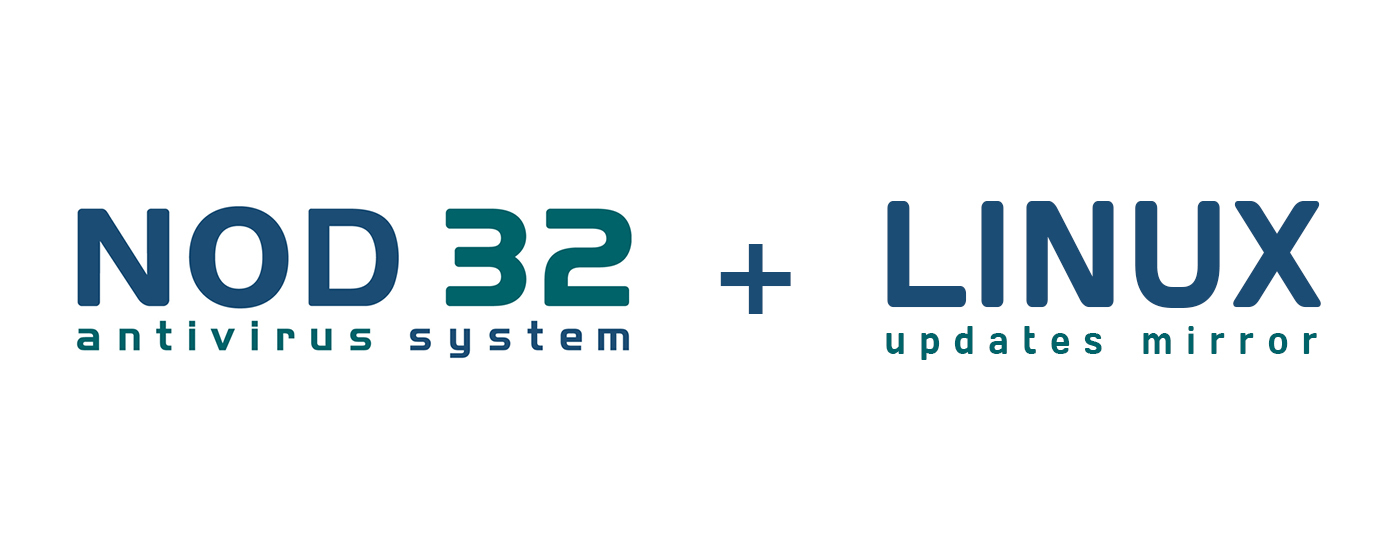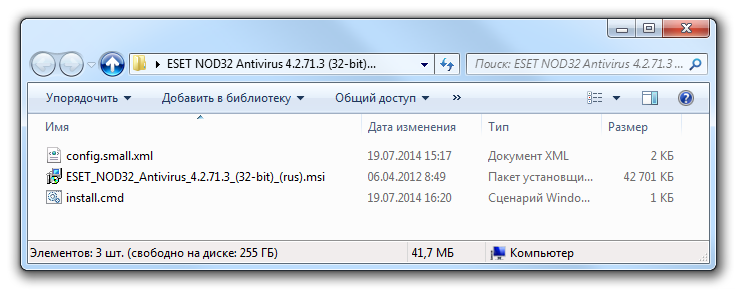The script to create mirror updates for Eset Nod32 on Linux
If you are administering, it is likely that sooner or later the question will arise - "On client machines, there is an Nod32 antivirus, we should create a single mirror of updates for them." And here there are several possible ways to develop the plot:
We will talk about the third option now.

')
After all these manipulations, you should observe something similar to:

Update: The post was rewritten on 02/09/2015, because its previous edition has lost its relevance to a greater extent
Update: 07/09/2016 The script was rewritten slightly less than full. If you used the old version earlier - I strongly recommend upgrading. Sources there are the same as always - on gita
- "Server on Windows, enough money." It's all quite simple - buy a license, put the desired Nod32 distribution on the server, set up, rejoice. The option is more mythical, since it is extremely rare when IT has “enough money”.
- "Server on Windows, not enough money." There are options. Starting from using warez licenses, to manual scripting and using Linux solutions ( cygwin to help).
- "Server on Linux". Money in this case simply does not matter. We have hands, we have a head, and there is a desire to do everything quite qualitatively and reliably.
We will talk about the third option now.

What will be changed for work?
- Unix system (tested on CentOS 7, FreeNas 9.3 and FreeBSD 8.3);
- Bash (tested on versions 4.1.11 (2), 4.2.24 (1) and 4.2.45 (1));
- Installed curl , wget , unrar (optional), and some other standard applications.
')
Installation
- Download the latest version and unpack:
$ cd /tmp $ wget https://github.com/tarampampam/nod32-update-mirror/archive/master.zip $ unzip master.zip; cd ./nod32-update-mirror-master/ - We transfer a set of scripts to a directory inaccessible "from the outside", but accessible to the user who will run it:
$ mv -f ./nod32upd/ /home/ - Go to the new location of the scripts and configure them (more on this in readme.md ):
$ cd /home/nod32upd/ $ nano ./settings.cfg - We give rights to run scripts:
$ chmod +x ./*.sh - Check for unrar if we plan to upgrade from the official Eset NOD32 mirrors:
$ type -P unrar - Perform a trial run:
$ ./update.sh
After all these manipulations, you should observe something similar to:

Special features
- It is completed with a script for automatically obtaining a working key from “pirated” resources. ATTENTION! THIS FUNCTIONAL ONLY FOR READING AND LEARNING ! YOU ARE RESPONSIBLE FOR ITS USE! USE ONLY LEGAL AND KEYS BOUGHT BY YOU!
- If an error occurred while updating from a server that is specified, for example, in
updServer0, an attempt is made to update from the server specified inupdServer1,updServer2..updServer10; - It downloads only updated update files (check is performed using
wget --timestamping); - It works only with the necessary types of updates, the necessary language and updates only for the necessary software (without this, the size of the update base is slightly more than 5.2 GB, with an indication of the types - 0.6 GB);
- It can only keep the update.ver file up to date without downloading the update files themselves (the mirror works, but it downloads not from your server, but from the source server of the updates);
- Included is a blank for the web interface of the update mirror (
./webfacedirectory).
MIT License
Copyright © 2014 <github.com/tarampampam>
This license permits those who receive a copy of this software and related documentation (hereinafter referred to as the “Software”) to use the Software without charge without restriction, including the unrestricted right to use, copy, modify, add, publish, distribute, sublicense and / or sale of copies of the Software, as well as to the persons to whom this Software is provided, subject to the following conditions:
The above copyright notice and these terms and conditions must be included in all copies or significant parts of this Software.
THIS SOFTWARE LIST IN NO EVENT SHALL THE AUTHORS OR COPYRIGHT HOLDERS BE LIABLE FOR CLAIMS FOR DAMAGES, LOSSES, OR OTHER REQUIREMENTS UNDER APPLICABLE CONTRACT, TORT OR OTHERWISE, ARISING FROM HAVING THE RESULT OF OR RELATED TO THE SOFTWARE OR THE USE OF THE SOFTWARE OR OTHER DEALINGS IN THE SOFTWARE.
This license permits those who receive a copy of this software and related documentation (hereinafter referred to as the “Software”) to use the Software without charge without restriction, including the unrestricted right to use, copy, modify, add, publish, distribute, sublicense and / or sale of copies of the Software, as well as to the persons to whom this Software is provided, subject to the following conditions:
The above copyright notice and these terms and conditions must be included in all copies or significant parts of this Software.
THIS SOFTWARE LIST IN NO EVENT SHALL THE AUTHORS OR COPYRIGHT HOLDERS BE LIABLE FOR CLAIMS FOR DAMAGES, LOSSES, OR OTHER REQUIREMENTS UNDER APPLICABLE CONTRACT, TORT OR OTHERWISE, ARISING FROM HAVING THE RESULT OF OR RELATED TO THE SOFTWARE OR THE USE OF THE SOFTWARE OR OTHER DEALINGS IN THE SOFTWARE.
Bonus '' Distribution kit with built-in settings ''
It's all very simple. Put 3 files in one folder:

In config.small.xml we specify the necessary settings:
Where %% url_updates_server %% is in both cases identical and equal to the address of our update server. The easiest way to get a config is “ESET NOD32 Antivirus” window → “Settings” → “Import and export settings”. From the received xml-file we delete everything, except for the necessary settings (the good is that all sections are very well named).
Next install install.cmd script:
And the whole thing with the help of the brainchild of Eugene Roshal is packaged in the SFX archive with the parameters:
Thus, when double-clicking on the received binary, silent unpacking in% TEMP% \ Nod32Install \ occurs, install.cmd is launched, which starts the installation of ESET_NOD32_Antivirus_4 . 2.71.3_ (32-bit) _ (rus) .msi with settings from config.small.xml without asking anything from the user, but showing the installation process. For inexperienced users - the most it.

In config.small.xml we specify the necessary settings:
<?xml version="1.0" encoding="utf-8"?> <ESET> <SECTION ID="1000103"> <SETTINGS> <PLUGINS> <PLUGIN ID="1000400"> <PROFILES> <NODE NAME="Enable" VALUE="1" TYPE="DWORD" /> <NODE NAME="Active" VALUE="@My profile" TYPE="STRING" /> <NODE NAME="@My profile" TYPE="SUBNODE"> <NODE NAME="UpdateType" VALUE="22" TYPE="DWORD" /> <NODE NAME="SelectedServer" VALUE="%%url_updates_server%%" TYPE="STRING" /> <NODE NAME="Username" VALUE="%%your_username%%" TYPE="STRING" /> <NODE NAME="Password" VALUE="" TYPE="PASS" /> </NODE> </PROFILES> <SETTINGS> <NODE NAME="RegistrationType" VALUE="0" TYPE="DWORD" /> <SERVERS> <NODE NAME="Server_0" VALUE="%%url_updates_server%%" TYPE="STRING" /> </SERVERS> </SETTINGS> </PLUGIN> </PLUGINS> <CLIENT> <NODE NAME="GraphicMode" VALUE="FFFFFFFF" TYPE="DWORD" /> <NODE NAME="ShowSplash" VALUE="0" TYPE="DWORD" /> <NODE NAME="SimpleMenu" VALUE="0" TYPE="DWORD" /> <NODE NAME="AdvancedMenu" VALUE="1" TYPE="DWORD" /> </CLIENT> </SETTINGS> </SECTION> </ESET> Where %% url_updates_server %% is in both cases identical and equal to the address of our update server. The easiest way to get a config is “ESET NOD32 Antivirus” window → “Settings” → “Import and export settings”. From the received xml-file we delete everything, except for the necessary settings (the good is that all sections are very well named).
Next install install.cmd script:
@echo off title "Run ESET Nod32 Installer" cls set AppToRun=ESET_NOD32_Antivirus_4.2.71.3_(32-bit)_(rus).msi set CfgFile=config.small.xml rem /qb - rem /qn - gui start "" "msiexec" /qb /package "%cd%\%AppPath%%AppToRun%" ADMINCFG="%cd%\%CfgPath%%CfgFile%" @echo on And the whole thing with the help of the brainchild of Eugene Roshal is packaged in the SFX archive with the parameters:
Path=%TEMP%\Nod32Install\ Setup=%TEMP%\Nod32Install\install.cmd Silent=1 Overwrite=1 Thus, when double-clicking on the received binary, silent unpacking in% TEMP% \ Nod32Install \ occurs, install.cmd is launched, which starts the installation of ESET_NOD32_Antivirus_4 . 2.71.3_ (32-bit) _ (rus) .msi with settings from config.small.xml without asking anything from the user, but showing the installation process. For inexperienced users - the most it.
If you have any questions, but you can not leave comments on this post or write to me in a personal - write comments on this post.
Update: The post was rewritten on 02/09/2015, because its previous edition has lost its relevance to a greater extent
Update: 07/09/2016 The script was rewritten slightly less than full. If you used the old version earlier - I strongly recommend upgrading. Sources there are the same as always - on gita
Source: https://habr.com/ru/post/232163/
All Articles
